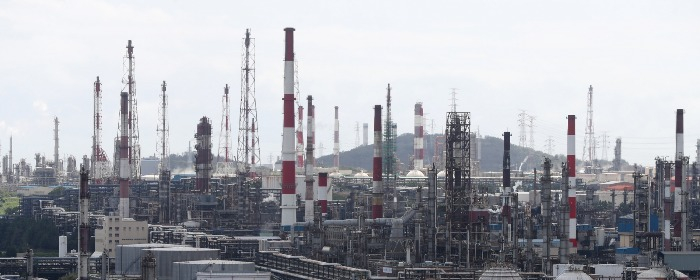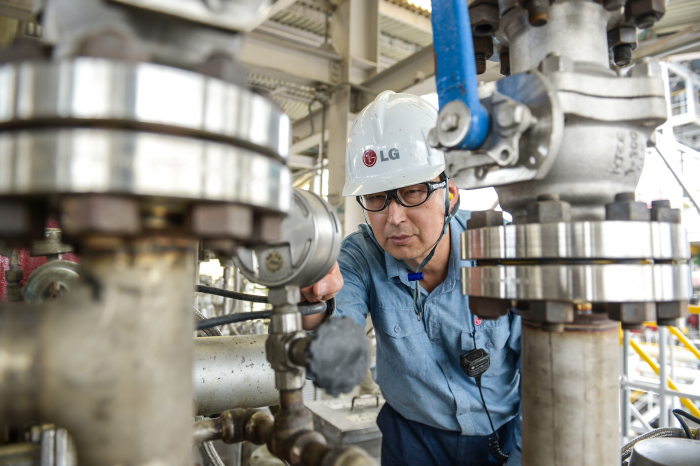Energy
Petrochem firms to fuel plants with self-supplied power
Petrochemical arms of SK, LG and Hanwha groups plan to build electricity-generating plants for stable energy supply
By Jun 23, 2022 (Gmt+09:00)
3
Min read
Most Read
S.Korea's LS Materials set to boost earnings ahead of IPO process


Samsung shifts to emergency mode with 6-day work week for executives


NPS to commit $1.1 billion to external managers in 2024


HD Hyundai Marine IPO sees strong demand from retail investors


Korean battery maker SK On expects business turnaround in H2



South KoreaŌĆÖs petrochemical companies will build power plants for the first time in their history to meet their rising energy needs on a stable basis, as the global energy crunch is showing no signs of easing.
The global shift toward eco-friendly products requires them to expand facilities, increasing their energy demand. Also, their electricity-generating plants will use eco-friendly fuels such as liquefied natural gas (LNG) and biomass energy to reduce carbon emissions.
The move will reduce their dependence on power utility KEPCO Co., which has a monopoly on power transmission and distribution, while cutting their energy costs.
SK Chemicals Co., a producer of chemical materials and healthcare products, is preparing to build its first LNG plant as it is expanding its production of eco-friendly products.
It will set a date for the groundbreaking ceremony at a board meeting next month, according to industry sources on Wednesday.
The LNG plant will have a 300-megawatt capacity, enough to power 80,000 households per year. It will be built on land measuring 37,965 square meters, adjacent to its Ulsan plant, 310 km southeast of Seoul.
The electricity generated from the plant will be supplied to SK ChemicalŌĆÖs production line of copolyester, a plastic material without environmental hormones, in the same region.
Its first-ever power plant to be built will also fuel SK Gas Ltd.ŌĆÖs propane de-hydrogenation (PDH) plant. SK Gas is a liquefied petroleum gas (LPG) supplier. In the PDH process, propane is dehydrogenated to propylene, which is used as fuel gas.
L'Or├®al S.A., the worldŌĆÖs largest cosmetics company and Johnson & Johnson, a US consumer health products company, are among SK ChemicalŌĆÖs main customers.
ŌĆ£Stable power supply becomes more important than ever as we're accelerating efforts to achieve carbon neutrality,ŌĆØ said an SK Chemical official.
SK Ecoplant Co., formerly SK Engineering & Construction Co., will handle the engineering, procurement and construction of the electricity plant, for which the petrochemical arm plans to spend 420 billion won ($323 million).

LG CHEM, HANWHA IMPACT
LG Chem Ltd. plans to team up with GS EPS Co. to build a biomass power plant in Yeosu, 320 km south of Seoul, which will be its first power plant. Electricity and industrial steam produced from the power plant will be used at LGŌĆÖs naphtha cracking center.
Hanwha Impact Co., a petrochemical arm of Hanwha Group, is carrying out a feasibility study of using hydrogen as a gas turbine fuel. If it proves feasible by the first half of next year, Hanwha will build such a plant and supply the power to its petrochemical plant in Daesan, 85 km southwest of Seoul.
South KoreaŌĆÖs power demand forecast
Unit: gigawatt
Source: MOTIE
Graphics by Jerry Lee
These companies are not alone in looking to produce electricity to fuel their plants.
Energy supply disruptions aggravated by the Russia-Ukraine war have highlighted the need to secure a stable energy supply, key in cracking naphtha, a petrochemical feedstock, all year round.
Back in 2021, a 16-minute blackout at a petrochemical plant in Ulsan caused tens of millions of dollars in lost production.
Hyundai Motor Co., South KoreaŌĆÖs No. 1 automaker, plans to build a large-scale LNG-fueled power plant to boost its energy self-sufficiency to more than 70%. It aims to complete the construction at the site of its main Ulsan factory by 2025 to reach carbon neutrality by 2045.
SK Hynix Inc., the worldŌĆÖs second-largest memory chipmaker, is in the final stage of building an LNG-based thermal power plant in Cheongju, North Chungcheong Province, where its main plant is located. It earmarked 800 billion won to build the power plant.
| South Korean companies' plans to build power plants |
||||
| Company | Type of power plant | Electricity generation capacity | When to start operation | |
| SK Chemical | LNG-based thermal power | 300 MW | 2024 | |
| Hyundai Motor | LNG-based thermal power | 184 MW | 2025 | |
| LG Chem | Biomass | Not available | 2025 | |
| Hanwha Impact | Hydrogen | Not available | 2023* | |
| *The year when Hanwha expects to complete a feasibility study | (Source: Companies) | |||
Write to Jeong-Min Nam at peux@hankyung.com
Yeonhee Kim edited this article.
More to Read
-
 Hydrogen economySK Gas, Lotte Chemical to launch JV for hydrogen power generation
Hydrogen economySK Gas, Lotte Chemical to launch JV for hydrogen power generationJun 02, 2022 (Gmt+09:00)
3 Min read -
 AutomobilesHyundai Motor to build LNG plant to power its factories
AutomobilesHyundai Motor to build LNG plant to power its factoriesMay 09, 2022 (Gmt+09:00)
3 Min read -
 EnergyKorea to require power plants to use more renewable energy resources
EnergyKorea to require power plants to use more renewable energy resourcesOct 07, 2021 (Gmt+09:00)
3 Min read
Comment 0
LOG IN


